Start with PowerPoint 2016
PowerPoint is a presentation-only program that allows you to create dynamic slide presentations. These presentations may include animations, images, videos and more. In this lesson, you'll learn how you work in a PowerPoint environment, with tools including Ribbon, Quick Access Toolbar, and Backstage view.
Start with PowerPoint 2016
- Learn PowerPoint 2016
- PowerPoint interface
- Work with the PowerPoint environment
- Ribbon
- Show and hide Ribbon
- Use the Tell me feature
- Quick Access Toolbar
- Ruler, guides and gridlines
- Zoom and other view options
- Convert slide view
- Zoom in and zoom out
- Backstage view mode
- Practice!
Learn PowerPoint 2016
PowerPoint 2016 is similar to PowerPoint 2013 and PowerPoint 2010. If you have used these versions before, you will feel that PowerPoint 2016 is familiar. But if you are new to PowerPoint or have more experience with older versions, you should first take some time to familiarize yourself with the interface of PowerPoint 2016.
PowerPoint interface
When you open PowerPoint for the first time, the Start Screen screen will appear. From here, you can create new presentations, select templates and access your recently edited presentations. From this Start Screen screen , locate and select Blank Presentation to access the PowerPoint interface.
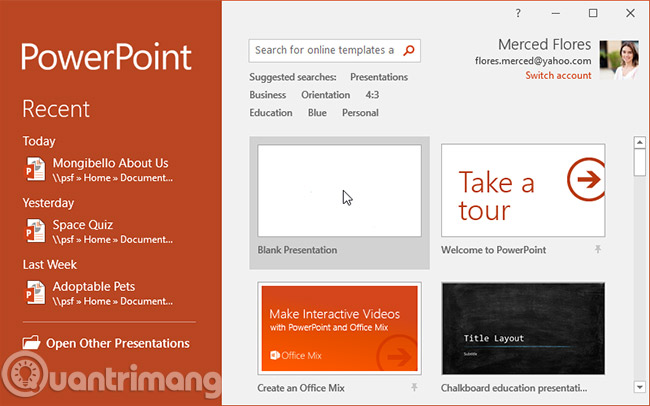
Click on the buttons in the screen below to familiarize yourself with the PowerPoint interface.

Work with the PowerPoint environment
The Ribbon and Quick Access Toolbar are where you will find commands to perform common tasks in PowerPoint. Backstage view gives you different options to save, open files, print and share your documents.
Ribbon
PowerPoint uses the Ribbon-based system instead of traditional menus. Ribbon contains many tabs, each tab has many groups of commands. For example, the Font group on the Home tab contains commands to format the text in your document.

Some groups also have small arrows in the bottom right corner, where you can click to get more options.
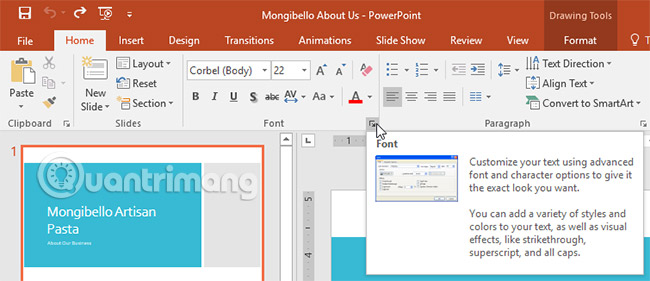
Show and hide Ribbon
The ribbon is designed to meet your current task, but you can minimize it if you find that it takes up too much screen space. Click the Ribbon Display Options arrow in the upper right corner of the Ribbon to display the drop-down menu.
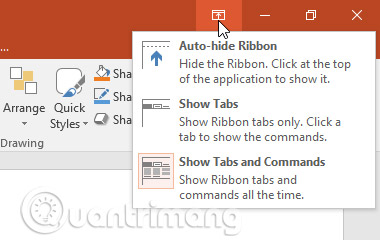
- Auto-hide Ribbon: The Auto-hide option displays your workbook in full screen mode and completely hides the Ribbon. To display the Ribbon, click the Expand Ribbon command at the top of the screen.
- Show Tabs: This option hides all groups of commands when they are not used, but the tabs will still show. To display the Ribbon, just click on a tab is okay.
- Show Tabs and Commands : This option enlarges the entire Ribbon. All tabs and commands will be displayed. This option is selected by default when you open PowerPoint for the first time.
Use the Tell me feature
If you have trouble finding the command you want, the Tell Me feature can help you. It works just like the regular search bar: Enter the content you are looking for and the options list will appear. You can then use the command directly from the menu without having to find the command on the Ribbon.
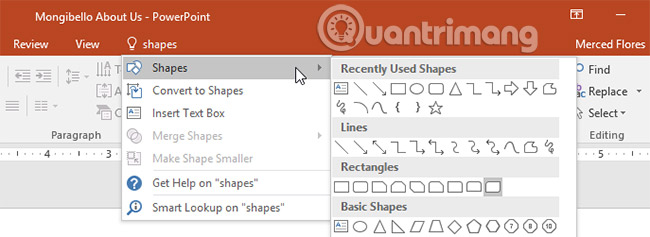
Quick Access Toolbar
Located just above the Ribbon, the Quick Access Toolbar allows you to access common commands regardless of which tab is selected. By default, it includes Save, Undo, Redo and Start From Beginning commands . You can add other commands depending on your preferences.
How to add commands to the Quick Access Toolbar:
1. Click the drop-down arrow to the right of the Quick Access Toolbar.
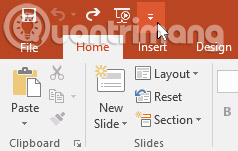
2. Select the command you want to add from the drop-down menu. To select more commands, select More Commands.
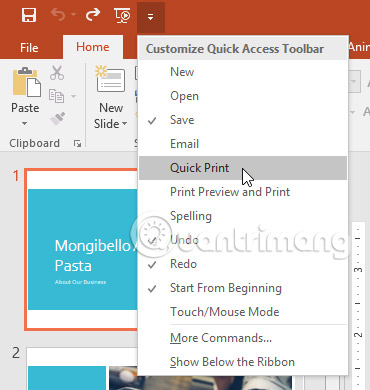
3. This command will be added to the Quick Access Toolbar.
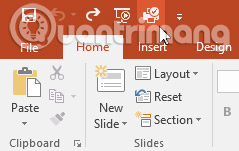
Ruler, guides and gridlines
PowerPoint includes a number of tools to organize and organize the content of your presentations, including Ruler, Guides and Gridlines. These tools make it easier to align objects in a presentation. Just click the checkboxes in the Show group on the View tab to display and hide these tools.
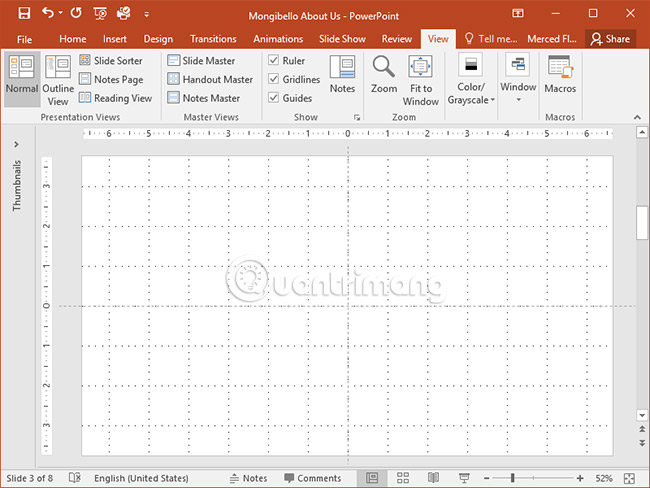
Zoom and other view options
PowerPoint has a variety of viewing options, changing the way your presentation is displayed. You can choose to view your presentation in Normal view, Slide Sorter view, Reading view , or Slide Show view . You can also zoom in and out to make your presentation easier to read.
Convert slide view
Switching between different slide views is easy. Just locate and select the desired slide view command in the bottom right corner of the PowerPoint window.

Zoom in and zoom out
To zoom in or out, click and drag the zoom control slider in the bottom right corner of the PowerPoint window. You can also choose + or - commands to zoom in or out. The number next to the slider displays the current zoom ratio, also known as the zoom level.

Backstage view mode
Backstage view gives you different options to save, open, print and share your presentation. To access the Backstage view, click the File tab on the Ribbon.
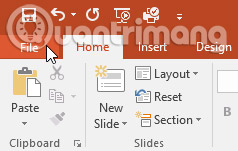
Click the buttons in the interaction below to learn more about how to use the Backstage view.
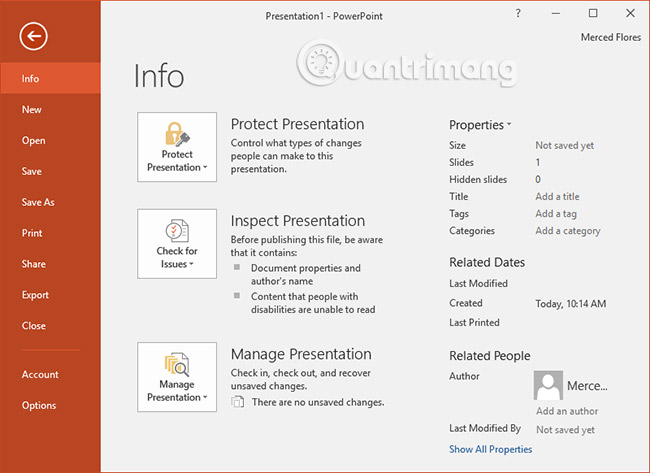
Practice!
1. Open PowerPoint 2016 and create a blank presentation.
2. Change Ribbon Display Options to Show Tabs.
3. Click the drop-down arrow next to Quick Access Toolbar and add New, Quick Print and Spelling commands .
4. In the Tell me bar , enter Shape and press Enter.
5. Select a shape from the menu and double-click somewhere on your slide.
6. Display the Ruler tool if it is not already displayed.
7. Enlarge the presentation to 120% size.
8. When you're done, your presentation will look like this:
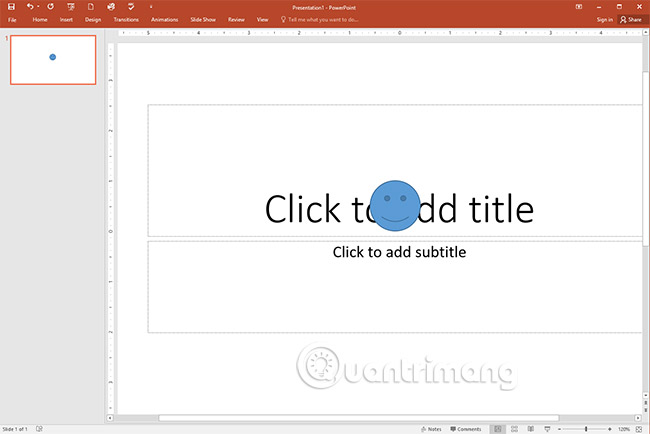
9. Change Ribbon Display Options back to Show Tabs and Commands mode.
See more:
- Summary of useful shortcuts in PowerPoint
- Create beautiful slides for PowerPoint presentations with 8 tips
- Presentation tips with Powerpoint
You should read it
- Sort and group objects in PowerPoint 2016
- Review presentations in PowerPoint 2016
- How to insert videos into PowerPoint 2016
- Presenting slide shows in PowerPoint 2016
- Use the Find & Replace feature in PowerPoint 2016
- Work with lists in PowerPoint 2016
- How to insert audio in PowerPoint 2016
- Basic information about slides in PowerPoint 2016
May be interested
- Create and open presentations in PowerPoint 2016
 powerpoint files are called presentations. whenever you start a new project in powerpoint, you will need to create a new presentation that can be completely refreshed or from a template.
powerpoint files are called presentations. whenever you start a new project in powerpoint, you will need to create a new presentation that can be completely refreshed or from a template. - How to turn off Start Screen on Office 15 for Mac fastest
 by default, when you open word, excel or powerpoint on office 15 for mac, you will see the start screen showing a list of document templates. if you want to skip this step and access the main interface directly, turn off the start screen according to the instructions below.
by default, when you open word, excel or powerpoint on office 15 for mac, you will see the start screen showing a list of document templates. if you want to skip this step and access the main interface directly, turn off the start screen according to the instructions below. - How to Loop in PowerPoint on PC or Mac
 this wikihow teaches you how to create a powerpoint presentation that loops indefinitely without requiring input from a presenter. you can do this using the powerpoint program on your windows or mac computer. open your powerpoint...
this wikihow teaches you how to create a powerpoint presentation that loops indefinitely without requiring input from a presenter. you can do this using the powerpoint program on your windows or mac computer. open your powerpoint... - How to include shapes in PowerPoint
 combining shapes in powerpoint creates more unique shapes in the slide.
combining shapes in powerpoint creates more unique shapes in the slide. - Instructions for creating charts on PowerPoint
 drawing a graph of powerpoint presentations is a basic operation. you can select different chart types for powerpoint presentations such as column charts, line charts, pie charts, bar charts, area charts, scattering charts.
drawing a graph of powerpoint presentations is a basic operation. you can select different chart types for powerpoint presentations such as column charts, line charts, pie charts, bar charts, area charts, scattering charts. - How to make PowerPoint for beginners
 creating powerpoint slides for making reports, presentations or lectures is very simple.
creating powerpoint slides for making reports, presentations or lectures is very simple. - Skills required when taking the MOS PowerPoint exam
 what is the structure of a powerpoint mos exam? what skills will you need to complete the test? let's find out the details.
what is the structure of a powerpoint mos exam? what skills will you need to complete the test? let's find out the details. - PowerPoint 2016: Create and open a presentation
 powerpoint files are called presentations. whenever you start a new project in powerpoint, you'll need to create a new presentation, either from scratch or from a template.
powerpoint files are called presentations. whenever you start a new project in powerpoint, you'll need to create a new presentation, either from scratch or from a template. - How to create a PowerPoint file password
 creating passwords for powerpoint slides helps you secure files, avoiding content duplication.
creating passwords for powerpoint slides helps you secure files, avoiding content duplication. - MS PowerPoint - Lesson 2: Creating a presentation slide ... Where to start?
 the answer is the task pane. just open the powerpoint presentation, the taskbar appears on the right side of the screen. task pane lists common operations that you can perform in powerpoint. help locate faster operations.
the answer is the task pane. just open the powerpoint presentation, the taskbar appears on the right side of the screen. task pane lists common operations that you can perform in powerpoint. help locate faster operations.










 How to save presentations in PowerPoint 2016
How to save presentations in PowerPoint 2016 How to enter 0 in Google Sheets
How to enter 0 in Google Sheets How to delete table format in Excel
How to delete table format in Excel Usage of Min and Max functions in Excel
Usage of Min and Max functions in Excel Lesson 22: Working with the Text Box
Lesson 22: Working with the Text Box